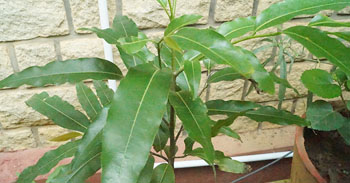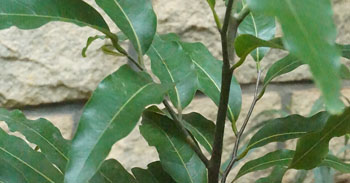KJC Medicinal Garden
Ubbina
Polyalthia longifolia
Order: Magnoliales
Family: Plantaginaceae
Genus: Monoon
Species: Polyalthia longifolia
Common Names: False ashoka
Native to Southern India and Sri Lanka.
Other plants of the same genus with medicinal properties
-
Monoon acuminatum
Monoon amischocarpum
Monoon anomalum
Monoon bathrantherum
Monoon costigerum
- Stem : Exhibits symmetrical pyramidal growth with willowy weeping pendulous branches.
- Polyalthia longifolia, is an Asian small tree.
- Leaves : lanceolate leaves with undulate margins.
- Fower : delicate star-like pale green flowers.
- Fruit : Is borne in clusters of 10–20, initially green but turning purple or black when ripe.
Uses in Tradition systems of medicine
- Antibacterial: leaves possess potent antimicrobials against Bacillus subtilis, Staphylococcus aureus, Escherichia coli, Pseudomonas aeruginosa, and Salmonella typhi.
- Antioxidant: stem bark, leaves exhibits antioxidant properties.
- Anti-inflammatory: the methanolic, and aqueous leaves extract of P. longifolia possess a significant anti-inflammatory activity.
- Antibacterial and antifungal: The seeds have reported antibacterial, and antifungal.
- Help treat acne
- Acts on uterine muscles and endometrium and thus provides relief from abdominal pain and other spasms.
- It also helps to treat irregular menstrual cycles, amenorrhea, leucorrhea, fibroids, cysts and other related disorders.
- Remove toxins from our blood and therefore provides excellent benefits for our skin.
Suggested Medicinal Properties
- Antibacterial: leaves possess potent antimicrobials against Bacillus subtilis, Staphylococcus aureus, Escherichia coli, Pseudomonas aeruginosa, and Salmonella typhi.
- Antioxidant: stem bark, leaves exhibits antioxidant properties.
- Anti-inflammatory: the methanolic, and aqueous leaves extract of P. longifolia possess a significant anti-inflammatory activity.
- Antibacterial and antifungal: The seeds have reported antibacterial, and antifungal activities.
- Hepatoprotective / the liver protective effect: The leaves administration reduces SGOT, SGPT, ALP, and bilirubin.
Active Phytochemicals
1. Diterpenoids
2. Alkaloids
3. Tannins
4. Mucilage
5. O-methylbulbocapnine-N-oxide
6. Polyfothine
7. N-methylnandigerine-N-oxide
8. oliveroline-N-oxide
9. pendulamine A
10. N-pendulamine B
11. 8-oxopolyalthiane
12. 13-dien-16, 15-olide
References
WHO. IUCN and WWF: Guidelines on the conservation of medicinal plants, IUCN Gland, Switzerland. 1993;1:4–6.
Bhagwati U. Utilization of medicinal plants by the rural women of Kulu, Himachal Pradesh. Indian J Trad Know. 2003;2:366–70.
Madhava Chetty, K., K. Sivaji and K. TulasiRao, 2008. Flowering plants of Chittoor district-Andhra Pradesh, India.1 edn. Students offset printers, Tirupati, pp: 14, 17, 18, 19, 25.
Plants of the World Online (POWO): Monoon longifolium (Sonn.) B.Xue & R.M.K.Saunders.

